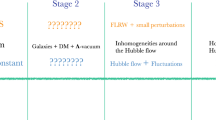Abstract
Astronomical observations of redshifts and the cosmic background radiation show that there is a local frame of reference relative to which the solar system has a well-defined velocity. Also, in cosmology the cosmological principle implies the existence of cosmic time and unique local reference frames at all spacetime points. On the other hand, in a fundamental postulate, the theory of special relativity excludes the possibility of the velocity of the Earth from entering into theories of local physics.
The theory put forward in this paper resolves this conflict between local physics and cosmology. The theory retains the essential ingredient of the mathematical structure of special relativity, namely covariance under the Lorentz symmetry group, but changes radically the interpretation of the physical significance of the Lorentz transformation. The theory is based on the postulate that in free space the fundamental interactions in physics are propagated with constant velocity with respect to the local rest frame. In Minkowski spacetime the local rest frame of reference defines a unique time axis and consequently a unique three-dimensional spatial hyperplane. One particularly important result of this is that the theory includes the classical notion of simultaneity. From the fundamental postulate it follows that the equations of local physics, when expressed in terms of the rest frame coordinate system, must be covariant under the Lorentz symmetry group. By the identification of the local rest frame with the (unique) cosmological local reference frame the two theories become mutually consistent.
The effects of the motion of the Earth on laboratory experiments are discussed. It is pointed out that existing experimental data do not discriminate between the present theory and that of special relativity: a proposal for an experimental test is made.
Similar content being viewed by others
References
P. G. Bergmann,Found. Phys. 1, 17 (1970).
H. Bondi,Observatory 82, 133 (1962).
S. G. Brush,Isis 58, 230 (1967).
J. P. Cedarholm and C. H. Townes,Nature (London) 184, 1350 (1959).
D. C. Champeney, G. R. Isaak, and A. M. Khan,Phys. Lett. 7, 241 (1963).
T. W. Cole,Mon. Not. R. Astr. Soc. 175, 93P (1976).
G. de Vaucouleurs and W. L. Peters,Astrophys. J. 287, 1 (1984).
A. Einstein,Ann. Phys. (Leipzig) 17, 891 (1905).
A. Einstein,Ann. Phys. (Leipzig) 49, 769 (1916).
A. Einstein, unpublished manuscript in the Pierpont Morgan Library, New York City (1921); quoted in Pais, Ref. 25.
G. F. FitzGerald,Science 13, 390 (1889); reproduced in Brush, Ref. 3.
J. C. Hafele and R. E. Keating,Science 177, 166 (1972).
J. C. Hafele and R. E. Keating,Science 177, 168 (1972).
H. J. Hay, S. P. Schiffer, T. E. Cranshaw, and P. A. Egelstaff,Phys. Rev. Lett. 4, 165 (1960).
M. Kline and I. W. Kay,Electromagnetic Theory and Geometrical Optics (Wiley, New York, 1965).
H. A. Lorentz,Versl. Kon. Akad. Wet. Amsterdam 1, 74 (1892).
H. A. Lorentz,Proc. Acad. Sci. Amsterdam 6, 809 (1904).
H. A. Lorentz,The Theory of Electrons (Teubner, Leipzig, 1909).
H. A. Lorentz,Nature (London) 106, 793 (1921).
P. Lubin, T. Villela, G. Epstein, and G. Smoot,Astrophys. J. 298, L1 (1985).
R. K. Luneburg,Mathematical Theory of Optics (University of California, Berkeley, 1964).
H. Minkowski,Nachr. Ges. Wiss. Göttingen 21, 53 (1908).
C. Møller,The Theory of Relativity, 2nd edn. (University Press, Oxford, 1972).
W. Noll,La Méthode Axiomatique dans les Méchaniques Classique et Nouvelles, Colloque International Paris, 1959 (Gauthier-Villars, Paris, 1963), pp. 47–56.
A. Pais,Subtle is the Lord ... (University Press, Oxford, 1982).
W. Pauli,Theory of Relativity (Pergamon, Oxford, 1958).
H. Poincaré,Rend. Circ. Mat. Palermo 21, 129 (1906).
Lord Rayleigh,Philos. Mag. 4, 678 (1902).
H. P. Robertson,Rev. Mod. Phys. 21, 378 (1949).
R. C. Tolman,Relativity Thermodynamics and Cosmology (University Press, Oxford, 1934).
C. Truesdell,A First Course in Rational Continuum Mechanics: Part I, Fundamental Concepts (Academic Press, New York, 1977).
S. Weinberg,Gravitation and Cosmology (Wiley, New York, 1972).
E. T. Whittaker,A History of the Theories of Aether and Electricity (The Modern Theories, 1900–1926) (Nelson, London, 1953).
Author information
Authors and Affiliations
Additional information
Address for the academic year 1990–1991: 415 Graduate Studies Research Center, University of Georgia, Athens, Georgia 30602.
Rights and permissions
About this article
Cite this article
Oliver, M.A. The reconciliation of physics with cosmology. Found Phys 21, 665–689 (1991). https://doi.org/10.1007/BF00733276
Issue Date:
DOI: https://doi.org/10.1007/BF00733276




